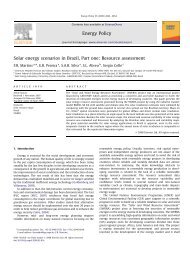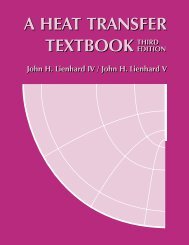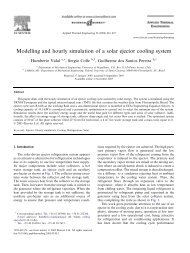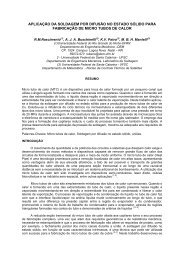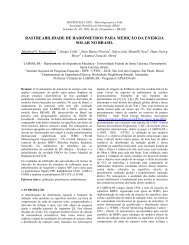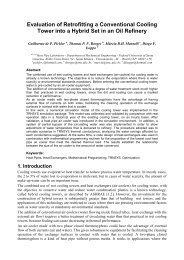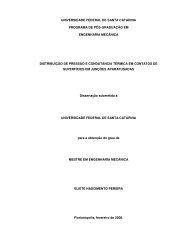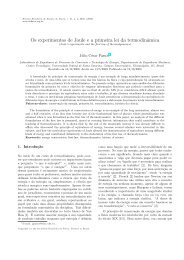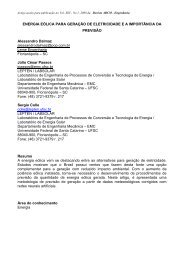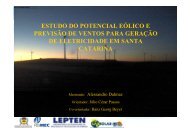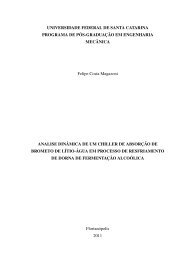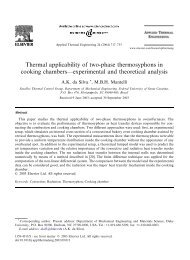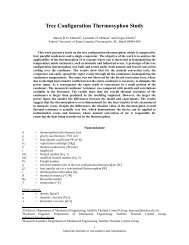site-dependent system performance and optimal inverter sizing of ...
site-dependent system performance and optimal inverter sizing of ...
site-dependent system performance and optimal inverter sizing of ...
Create successful ePaper yourself
Turn your PDF publications into a flip-book with our unique Google optimized e-Paper software.
SITE-DEPENDENT SYSTEM PERFORMANCE AND OPTIMAL INVERTER SIZING OF<br />
GRID-CONNECTED PV SYSTEMS<br />
Bruno Burger' & Ricardo Riithe<br />
'Fraunh<strong>of</strong>er Institute for Solar Energy Systems SE, Deparfment <strong>of</strong> Electrical Energy Systems<br />
Heidenh<strong>of</strong>str, 2,791 IO Freiburg - GERMANY<br />
Tel.: *49 761 4588 5237 FAX: +49 761 4588 9237 Email: bruno.burger@ise.fraunh<strong>of</strong>er.de<br />
'LABSOLAR - Laboratorio de Energia Solar & LabEEE - Laboratbrio de Eficigncia Energetica em Edificaq6es<br />
Universidade Federaf de Santa CatarindUFSC, Caixa Postal 476, Florianopolis - SC, 88040-9QO. BWlL<br />
Tel.: +55 48 331 5174 FAX: +55 48 331 7615 Email: ruther@mboxl.ufsc.br<br />
ABSTRACT<br />
The <strong>sizing</strong> <strong>of</strong> gridconnected PV <strong>system</strong>s does not<br />
usually take into account the <strong>site</strong>-<strong>dependent</strong> peculiarities<br />
<strong>of</strong> the solar irradiation distribution characteristics. Because<br />
<strong>of</strong> the perceived notion that PV <strong>system</strong>s will hardly ever<br />
have a DC output equal to or above their STCrated<br />
nominal power, <strong>inverter</strong>s are usually sized with a nominal<br />
AC output power some 30% (sometimes even more)<br />
below the PV array nominal power. This practice might<br />
lead to considerable energy losses, especially in the case<br />
<strong>of</strong> PV technologies with low temperature coefficients <strong>of</strong><br />
power <strong>and</strong> at <strong>site</strong>s with warm climates <strong>and</strong> an energy<br />
distribution <strong>of</strong> sunlight shifted to higher irradiation levels.<br />
We discuss the consequences <strong>of</strong> the time resolution <strong>of</strong> the<br />
irradiation data set used to determine a particular <strong>site</strong><br />
irradiation distribution on <strong>inverter</strong> siring. Most <strong>of</strong> the<br />
available irradiation data measured at individual <strong>site</strong>s are<br />
hourly averages, which read to fiftering <strong>of</strong> irradiation<br />
peaks, which might result in inaccurate <strong>performance</strong><br />
estimations. When calculating <strong>inverter</strong> yearly efficiencies<br />
using both hourly averages <strong>and</strong> one-minute averages <strong>of</strong><br />
the solar irradiation, we can show that the actuaf losses<br />
due to <strong>inverter</strong> under<strong>sizing</strong> increase with increased time<br />
resolution, revealing that hourly averages hide important<br />
irradiation peaks.<br />
INTRODUCTION<br />
Grid-connected applications are the fastest growing<br />
segment <strong>of</strong> the photovoltaic (PV) market. with premium<br />
feed-in tariffs available in many countries [I]. In many<br />
situations, optimizing the PV amy energy yield will justify<br />
the extra cost that might be incurred by this optimization,<br />
<strong>and</strong> <strong>inverter</strong> <strong>sizing</strong> might be an interesting design aspsct<br />
to look into. System design recommendations for gridconnected<br />
PV installations usually lead to <strong>inverter</strong>s with a<br />
nominal power considerably smaller than the PV array's<br />
nominal power. Because <strong>of</strong> the perceived notion that PV<br />
<strong>system</strong>s will hardly ever have a DC output equal to or<br />
above their STC-rated (STC = 1000 W/m2; AM 1.5<br />
spectrum, operating cell temperature 25%) nominal<br />
power, <strong>inverter</strong>s are usually sized with a nominal power<br />
some 30% (sometimes even more) below the W array<br />
nominal power [2-7]. Furthermore, <strong>inverter</strong> technology has<br />
evolved considerably in recent years, with improved<br />
efficiency curves especially at partial loads, <strong>and</strong> PV<br />
module nominal power tolerances, which used to be +or-<br />
10% (in practice more <strong>of</strong>ten -10% than +IO% [S.9]) are<br />
today evolving to + or - 2.5% [IO]. In practice, recent<br />
measurements on 100 new PV modules made at the<br />
Fraunh<strong>of</strong>er ISE [I 11 have resulted in a mean-3.4% power<br />
deviation from STC, with a considerable amount <strong>of</strong><br />
modules with deviations close to -10%.<br />
Especially for the market-dominant crystalline silicon<br />
(c-Si) PV technology. which presents a strong negative<br />
coefficient <strong>of</strong> power, the high irradiation levels that lead to<br />
maximum output are associated with high cell operating<br />
temperatures, which usually prevent the PVarray to reach<br />
its nominal DC power. This rationale has led to a rule <strong>of</strong><br />
thumb, by which <strong>inverter</strong> nominal AC power can be<br />
designed lower than the PV array nominal DC power. This<br />
'practice might lead to considerable energy losses,<br />
especially in the case <strong>of</strong> PV technologies with IOW<br />
temperature coefficients <strong>of</strong> power like thin film amorphous<br />
silicon (a-Si) <strong>and</strong> Cadmium Telluride (CdTe). at <strong>site</strong>s with<br />
warm climates, high incidence <strong>of</strong> clear skies, <strong>and</strong> an<br />
energy distribution <strong>of</strong> sunlight shifted to higher irradiation<br />
levels [IZ]. It has been shown that +Si output<br />
<strong>performance</strong> stabilizes at different levels depending on the<br />
particular <strong>site</strong> prevailing temperature conditions, with<br />
higher stabilized <strong>performance</strong> levels at <strong>site</strong>s with a year-<br />
round higher temperature [I 31.<br />
State-<strong>of</strong>-the-art <strong>inverter</strong>s reach peak efkiencies in<br />
the 95% - 97% range, with efficiency curves which differ<br />
in shape due to basically two different optimization<br />
approaches: (i) a low self-consumption strategy leads to<br />
high efficiency at small partial loads (at 0 to 10% <strong>of</strong><br />
nominal power range). at the expense <strong>of</strong> <strong>performance</strong> at<br />
the higher end <strong>of</strong> the curve (at nominal power) <strong>and</strong> peak<br />
efficiency at partial loads usually below 50% <strong>of</strong> nominal<br />
load; <strong>and</strong> (ii) a small input power level dependency<br />
strategy (for loads above - 30% <strong>of</strong> nominal) leads to good<br />
<strong>performance</strong> at the higher end <strong>of</strong> the curve, at the<br />
expense <strong>of</strong> <strong>performance</strong> at small partial loads (at 0 to 10%<br />
<strong>of</strong> nominal power range) [2].<br />
0-7803-87074/05/$20.00 02005 IEEE.<br />
1675<br />
Authorized licensed use limited to: UNIVERSIDADE FEDERAL DE SANTA CATARINA. Downloaded on November 25, 2008 at 13:39 from IEEE Xplore. Restrictions apply.
'<br />
The first strategy is more commonly used by <strong>inverter</strong><br />
manufacturers <strong>and</strong> typically, <strong>inverter</strong> efficiencies peak at<br />
30 to 40% <strong>of</strong> nominal power, with somewhat reduced<br />
effkiencies at full load. Undersized <strong>inverter</strong>s might<br />
therefore operate closer to full capacity (<strong>and</strong> therefore<br />
below maximum <strong>performance</strong> levels) more <strong>of</strong>ten,<br />
depending on the <strong>site</strong> distribution <strong>of</strong> irradiation levels.<br />
Because undersized <strong>inverter</strong>s will operate at full load more<br />
<strong>of</strong>ten, they will reach operating temperatures that might<br />
trigger temperature-reducing features <strong>of</strong> their algorithms,<br />
leading to further energy losses. Figure 1 shows a typical<br />
<strong>inverter</strong> efficiency vs. % <strong>of</strong> nominal capacity curve,<br />
including power limitation losses due to overloading [ 141.<br />
65 I I<br />
-_<br />
0 0.2 0.4 0.6 0.8 1.0 1.2 1.4<br />
Pk I L,<br />
Fig. 1: Typical <strong>inverter</strong> efficiency curve as a function <strong>of</strong> loading (X<br />
<strong>of</strong> nomiiral AC power), including power limitation lases for input<br />
power levels above the <strong>inverter</strong> nominal p e r 1141.<br />
Radiation levels above 900Wlm' occur some 10% <strong>of</strong><br />
the time, <strong>and</strong> the coriesponding energy fraction is<br />
above 31%. Figure 4 shows, also for the Freiburg <strong>site</strong>, but<br />
for mean hourly values; the energy distribution <strong>of</strong> the<br />
incoming solar radiation. with the same format presented<br />
in figures 2 <strong>and</strong> 3, The figure shows how the hourly<br />
averages tend to smooth out maxima, resulting in a<br />
distribution pr<strong>of</strong>ile which is quite different from the ones<br />
resulting from figures 2 <strong>and</strong> 3. <strong>and</strong> a shift <strong>of</strong> the energy<br />
content to lower irradiation levels. While still over 63% <strong>of</strong><br />
daytime hours present radlation levels 1.300W/m2, with<br />
a corresponding energy content <strong>of</strong> some 20% <strong>of</strong> the total<br />
incident energy, less than 3% <strong>of</strong> daytime hours present<br />
radiation levels 1 1000Wlm2, corresponding to some 9%<br />
<strong>of</strong> the incident energy. These results differ considerably<br />
from what is seen for IGseconds or oneminute<br />
resolutions, demonstrating that the use <strong>of</strong> hourly averages<br />
hides important information <strong>and</strong> is not representative <strong>of</strong><br />
the real solar resource distribution pr<strong>of</strong>iles. Radiation<br />
levels above 900Wlm' occur - 7% <strong>of</strong> the time, <strong>and</strong> the<br />
corresponding energy fraction Is just above 23%. It is<br />
thus clear that the real energy content at these higher<br />
irradiation levels is underestimated when using hourly<br />
averages.<br />
r51i I .<br />
I 2f2tL7<br />
I I I L<br />
IRRADIATION DATA SAMPLING RATE<br />
Based on global horizontal irradiation data measured<br />
by pyranometers located at the Fraunh<strong>of</strong>er ISE in Freiburg<br />
(48' N. Germany, with typical yearly global horizontal<br />
radiation - 1150kWh/mz) at 10-second intervals, <strong>and</strong> at<br />
the Solar Energy Research Laboratory - LABSOLAR in<br />
Florianopolis (27' S, Brazil, with typical yearly global<br />
horizontal radiation - 1 550kWh/m2) at one-minute<br />
intervals, we have studied the distribution <strong>of</strong> the incoming<br />
solar radiation at these <strong>site</strong>s as instant values (Freiburg),<br />
<strong>and</strong> as oneminute <strong>and</strong> hourly averages (Freiburg <strong>and</strong><br />
Florianopolis) at 30 degrees tilted surfaces.<br />
Figures 2 <strong>and</strong> 3 show, for the Freiburg <strong>site</strong> <strong>and</strong><br />
respectively for 10-second instant values <strong>and</strong> for oneminute<br />
averages, the energy distribution <strong>of</strong> the incoming<br />
solar radiation, distributed at 50W/m2 bins, with bars<br />
representing the percentage <strong>of</strong> the energy content at the<br />
respective radiation level interval, <strong>and</strong> solid lines<br />
representing the percentage <strong>of</strong> daytime hours (i.e.,<br />
irradiation > 2Wlm ) when radiation levels occur at the<br />
particular interval considered. The results for these two<br />
different time resolution sampling rates are very similar,<br />
<strong>and</strong> both figures demonstrate that while over 63% <strong>of</strong> the<br />
daytime hours present radlation levels 5 300W/m2, the<br />
corresponding energy content represents only some 20%<br />
<strong>of</strong> the total incident energy. Looking at the high end <strong>of</strong><br />
the radiation level distribution shows that onty some 5% <strong>of</strong><br />
the daytime hours present radlation levels 2 1 OOOW/mz,<br />
but the corresponding energy content is over 16%.<br />
I<br />
I<br />
Fig. 2: Distribution <strong>of</strong> instant dues (90 sac. resolution =<br />
3.153.600 instant values) <strong>of</strong> solar radiation d 30' tilt at the<br />
Freiburg <strong>site</strong>. sorted at 50W/m2 bins, with bars representing the %<br />
<strong>of</strong> the solar energy content ai the paticular interval, <strong>and</strong> the did<br />
line representing the % <strong>of</strong> daytime hours at the respecthm<br />
irradiation level.<br />
0 2W 400 Bw 800 1COO 12W Wr"<br />
Fig. 3: Distribution <strong>of</strong> tho, one-minute averages (525.600 mean<br />
values) <strong>of</strong> the solar radiation at 30" I at the Freiburg <strong>site</strong>, sorted<br />
at 50Wlm' bins, with bars representlng the % <strong>of</strong> the solar energy<br />
content at the particular interval, <strong>and</strong> the solid line presenting<br />
the % <strong>of</strong> daytime hours at the respective iadiation level.<br />
1676<br />
Authorized licensed use limited to: UNIVERSIDADE FEDERAL DE SANTA CATARINA. Downloaded on November 25, 2008 at 13:39 from IEEE Xplore. Restrictions apply.
I i2h<br />
Fig. 4: Distribution <strong>of</strong> the hourly alverages (8760 mean dues) <strong>of</strong><br />
the solar radiation at 30' tilt at the Freiburg <strong>site</strong>, sorted at 50W/m2<br />
bins. with bars representing the % <strong>of</strong> the solar energy content at<br />
the particular interval, <strong>and</strong> the solid line representing the 96 <strong>of</strong><br />
daytime hours at the respective irradiation level.<br />
looking at the solar energy resource distribution at<br />
the Florianopolis <strong>site</strong>, respectively at oneminute <strong>and</strong><br />
hourly averages, figures 5 <strong>and</strong> 6 show that while over 50%<br />
<strong>of</strong> the daytime hours present radiation levels<br />
300Wlm2, the corresponding energy content is less than<br />
15% <strong>of</strong> the total incident energy. At these low-light<br />
levels there is not much difference between the two<br />
different time resolutions. Considerable differences<br />
emerge when looking at the high end <strong>of</strong> the radiation level<br />
distribution. which shows for the oneminute averages that<br />
some 9% <strong>of</strong> the daytime hours present radiation levels<br />
- s t000W/m2, with a corresponding energy content <strong>of</strong><br />
some 23%; hourly averages for the same range<br />
correspond to around 6% <strong>of</strong> daytime hours, <strong>and</strong> below<br />
11% <strong>of</strong> the total energy content. Radiation levels above<br />
900W/m2 occur some 16% <strong>of</strong> the time when looking at<br />
one-minute averages, <strong>and</strong> below 3% <strong>of</strong> daytime hours<br />
when using hourly averages, with corresponding energy<br />
fractions respectively above 38% <strong>and</strong> 25%.<br />
Fig. 6: Distributim <strong>of</strong> the hourly averages (8760 mean values) <strong>of</strong><br />
the solar radiation at 30' tilt at the Fforianopolis <strong>site</strong>, sorted at<br />
50W/m2 bins, with bars representing the % <strong>of</strong> the solar energy<br />
content a1 the particular interval, <strong>and</strong> the solid line rqressnting<br />
the % <strong>of</strong> dayl" hours at the respective irradiation level.<br />
INVERTER YEARLY EFFICIENCY AND LOSSES<br />
Figure 7 shows <strong>inverter</strong> yearly efficiency curves.<br />
including power limitation losses, for the Freiburg <strong>site</strong> as it<br />
function <strong>of</strong> the relation between the solar generator DC<br />
power rating <strong>and</strong> the <strong>inverter</strong> AC nominal rating.(ratio PSG<br />
I PinvAc-nom), calculated for the three different solar<br />
radiation data time resolutions studied. The solid line<br />
corresponds to instant (10-second) data, the dashed line<br />
corresponds to mean minute values, <strong>and</strong> the dotted line<br />
corresponds to mean hourly values. It can be noticed that<br />
hourly averages lead to undersized <strong>inverter</strong>s with respect<br />
to the PV generator DC nominal power. Figure 8 shows<br />
the <strong>inverter</strong> yearly losses due to power limitation for the<br />
same irradiation data, again demonstrating that hourly<br />
averages <strong>of</strong> solar radiation lead to underestimating the<br />
real losses that. will occur with increasing the solar<br />
generator size with respect to the <strong>inverter</strong>s nominal power.<br />
Figures 9 <strong>and</strong> 10 show respectively for the Florianopolis<br />
<strong>site</strong>, the <strong>inverter</strong> yearly efficiency curves. including power<br />
limitation losses, <strong>and</strong> the <strong>inverter</strong> yearly losses due to<br />
power limitation. Solid lines correspond to mean minute<br />
values, <strong>and</strong> dashed lines correspond to mean hourly<br />
values. It can be seen that if PSG I Pinv.~~-nom is set above<br />
1.1, hourly averages tend to overestimate efficiency <strong>and</strong><br />
underestimate losses, demonstrating the experimental<br />
artifact induced by the use <strong>of</strong> the lower time resolution<br />
radiation data.<br />
I<br />
Fig. 5: Distribution <strong>of</strong> the oneminute averages (525.600 mean<br />
values) <strong>of</strong> the solar radiation at 30' tiit at the Florianopdis <strong>site</strong>,<br />
sorted at 50W/m2 bins. with bars representing the % <strong>of</strong> the solar<br />
energy content at the particular interval, <strong>and</strong> the solid line<br />
representing the % <strong>of</strong> daytime hours at Re respective inadiation<br />
level.<br />
I<br />
CONCLUSIONS<br />
Using instant (10-seconds), one-minute <strong>and</strong> hourly<br />
averages <strong>of</strong> solar radiation data for Freiburg - Germany,<br />
<strong>and</strong> one-minute <strong>and</strong> hourly averages <strong>of</strong> solar radiation<br />
data for Florianopolis - Brazil. we have shown the effects<br />
<strong>of</strong> data sampling on the optimum <strong>inverter</strong> <strong>sizing</strong> <strong>of</strong> gridconnected<br />
PV <strong>system</strong>s. When calculating <strong>inverter</strong> yearly<br />
efficiency values, <strong>and</strong> yearly losses due to <strong>inverter</strong> power<br />
limitation, using both hourly averages <strong>and</strong> onwninute<br />
averages <strong>of</strong> solar irradiation, we have demonstrated that<br />
the estimation <strong>of</strong> the actual losses due to <strong>inverter</strong><br />
e<br />
1677<br />
Authorized licensed use limited to: UNIVERSIDADE FEDERAL DE SANTA CATARINA. Downloaded on November 25, 2008 at 13:39 from IEEE Xplore. Restrictions apply.
~~ -<br />
under<strong>sizing</strong> increases with increased time resolution <strong>of</strong> the<br />
radiation measurements, revealing that hourly averages<br />
hide important irradiation peaks. In fact, results with hourly<br />
averages are an experimental artifact, <strong>and</strong> lead to an<br />
estimation <strong>of</strong> the solar energy resource distribution that<br />
does not correspond to reality. Hourly averages <strong>of</strong><br />
irradiation values lead to <strong>inverter</strong> under<strong>sizing</strong> <strong>and</strong> the<br />
associated energy losses.<br />
Fig. IO: Inverter yearly losses due to power limitation af the<br />
Flohnopolis siie vs. <strong>inverter</strong> <strong>sizing</strong>. Solid line = mean minute<br />
values; dotted line = mean hourly values <strong>of</strong> the solar radiation.<br />
REFERENCES<br />
h G J P"X--<br />
Fig. 7: Inverter yearly Efficiency, including power limitation losses,<br />
at the Freiburg <strong>site</strong> vs. <strong>inverter</strong> <strong>sizing</strong>. Solid tine = instant (10-<br />
second) values: dashed line = mean minute values; dotted line =<br />
mean hourlv values <strong>of</strong> the solar radiation.<br />
Fig. 8 Inverter yealy losses due to power limitation at the<br />
Freiburg <strong>site</strong> ys. <strong>inverter</strong> <strong>sizing</strong>. Solid line = instant (lcsecond)<br />
values; dashed line = mean minute values; dotted line = mean<br />
hourly values <strong>of</strong>the solar radiation.<br />
0.4 0.5 OB 07 0.11 0.9 1.0 1.1 1 1 I3 1.4<br />
pm Pn,K-N%<br />
Fig. 9 Inverter yealy efficiency (in %), including power limitation<br />
losses, at the Florianopolis <strong>site</strong> vs. <strong>inverter</strong> <strong>sizing</strong>. Solid line =<br />
mean minute values; dotted line = mean hourly Mues <strong>of</strong> the solar<br />
wdiatbn.<br />
[l] E. Psrezqua, F. Oemaq. 2.1. Alfemu, J.I. Bai. K. de Segunda<br />
8. Dimmler, A. Goatzberger. C. 1. Beunza, W. tojkowski, S. Novuak,<br />
W. Sinke, P. van der Vleuten. R. va Zolingen, A vision for PV<br />
technology for 2030 <strong>and</strong> beyond, Prelim. report Future Vision for PVr<br />
A Vision for PV Techndcgy for 2030 <strong>and</strong> Beyon4 Brussels-Belgium,<br />
2004. pp. 1-40.<br />
[2] M. Jantsch, Systemfechnische Untersuchung des Nutzungsgmdes<br />
photovolfaischer Anlagen - Analyse und Optimiewng von Strukiumn<br />
und Wirkungszusammenhangen, Ph. D. Thesis, UniversiiBt<br />
Fredericiana Karlsruhe, ISBN 3-18-333606-5, VDI Verlag, DOssetdorC<br />
Germany, 1996, pp. 1-124.<br />
[3] N.J.C.M. van der Borg 8 AR. Burgers, lnverter undersiring in PV<br />
<strong>system</strong>s, 3' World Conf. on PV Solar Energy Cmv., Osakdapan,<br />
2003, pp. 517-520.<br />
[4] A. Woyte, S. Islam L K. Arenbgg, Undersiring the <strong>inverter</strong> for grid-<br />
connedon - where is the optimum,<br />
I@ Symposium PV<br />
Sdarenergie, Bad StafklsteikGermany, 2003, pp. 414419.<br />
[5] R. Zilles 8 S.H.F. Oliveira, 6.3kWp PV building infegmlion at Sao<br />
Paul0 Univets@, 17* Europ. PV Soiar Energy Conf., Mnich-<br />
Germany. 2001, pp. 1975-1978.<br />
161 L. Keller & P. Affolter, Oplimiring the panel m a <strong>of</strong> PV <strong>system</strong> in<br />
relation to the static <strong>inverter</strong>, Solar Energy, 55, 1995, pp. 1-7.<br />
p] A. Pregelj, M. Begovic & A. Rohatgi, Impact <strong>of</strong> inverler<br />
configuration on PV <strong>system</strong> reliability <strong>and</strong> energy produdon. 2Sh<br />
IEEE PV Spec. Conf., New Orleans-USA, 2002, pp. 13881391.<br />
[E] R. Zilles, C. Ribeiro 8. M. Moszkowicz, Power rating <strong>and</strong> the rreed<br />
<strong>of</strong> PV modules measurements in Brazilian dissemination program 2&<br />
World Conf. on PV Energy hv., ViennaAustria, 1998, pp. 2004<br />
2032.<br />
191 LA. Heddhsuer. A. Krenzlngff 8 C.W.M. Prieb, Rated versus<br />
measured power <strong>of</strong> PV modules used in Brazilian rural properties<br />
electrification, 17* Europ. PV Solar Energy Ccnf., Munich-Gennany,<br />
2001, pp. 800-803.<br />
[IO] PHOTON International - The Photovoltaic Magazine (2004),<br />
Annual PV module piurvey, March 2004.<br />
[I l]K. Kiefer, Fmunh<strong>of</strong>er IS€ Annual Report, 2004.<br />
[12] R. RCrther. H.G. Beyer, A.A. Montenegro, M.M. Daccqio, I.T.<br />
Salamoni 8 P. Knob, Performance results <strong>of</strong> the first gridconnected,<br />
thin-film PV installation in Brazil: temperature behaviour <strong>and</strong><br />
perlbmance ratios over sir years <strong>of</strong> continuous operation, lgm Eump.<br />
PV Solar Energy Conf., Paris- France, 2004, pp. 3091-3094.<br />
1131 R. ROther. G.T. Mani, J. del Cueto, J. Adelslein, A. Montenegro 8<br />
B. von Roedern (2003), Performance test <strong>of</strong> amorphous silicon<br />
modules in dfimnt dimates:. higher minimum operating temperatures<br />
Iead to higher peff&"nce levels, 3" World Con€ on PV Energy<br />
Conv., Osaka-Japan. 2003, pp. 501-504.<br />
[14] Sunwap (ZW), Sunways NT 6000 Inverter,<br />
www.sunways.delem/pr~u~~~larinve~er~echni~~~~.php.<br />
1678<br />
Authorized licensed use limited to: UNIVERSIDADE FEDERAL DE SANTA CATARINA. Downloaded on November 25, 2008 at 13:39 from IEEE Xplore. Restrictions apply.



